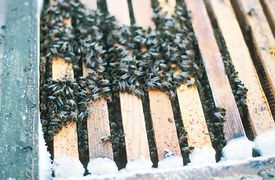Winter to Spring
Jump to navigation
Jump to search
The brown bee's physiology and behavior differs from other European honey bee subspecies. This becomes especially apparent in the overwintering capacity of the brown bee. Long and harsh winters and windy weather together with strong nectar flow from heather (Calluna vulgaris) in Atlantic shore climate zones have been important adaptive factors during the evolution of this subspecies. These evolutionary specialities should be taken into account when managing A. m. mellifera bees.
List of brown bee-specific features pertaining to overwintering:
- Nordic bees often stay in a winter cluster longer than other subspecies.
- They need proper, peaceful winter rest, especially before the cleansing flight in spring when the hind gut is filled with feces.
- The comparatively small winter cluster sets down near the flight entrance.
- The size of the winter cluster is, on average, smaller than that of many other subspecies’.
- The small and tight winter cluster can withstand high concentrations of Carbondioxide (CO₂).
- The bees in the cluster can stand more mineral components in winter food than other subspecies (adaptation to a long winter and to Calluna honey in winter feed stores)
- Nordic bees usually fly the cleansing flight later or even without being noticed in comparison to other subspecies.
- The bees’ winter food consumption is lower and they are not in such a hurry to do the cleansing flight.
- Typically, very few individual bees die during overwintering.
- Nordic bees don't come out from the hive during overwintering, nor do they have “snow blanket” losses.
- The bee colonies' development during spring is slow, but the winter bees are long-living.
- A small number of adult bees can take care of a large brood area in spring.
- Nordic bees are easy to manage in the spring, as they don’t starve, and they usually have lot of winter feed left immediately after the cleansing flight,
- The bee colony develops strongly in the end of May and June.
